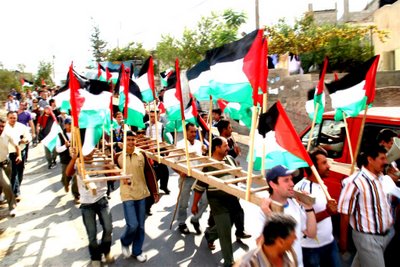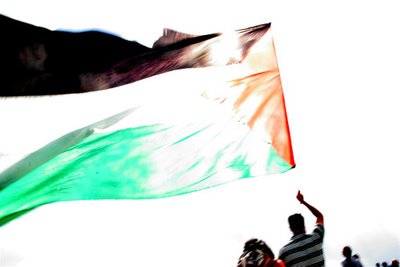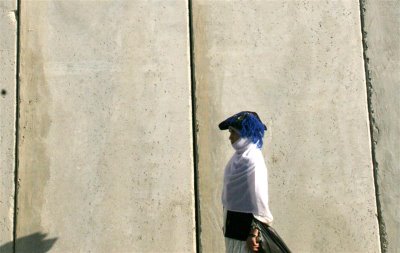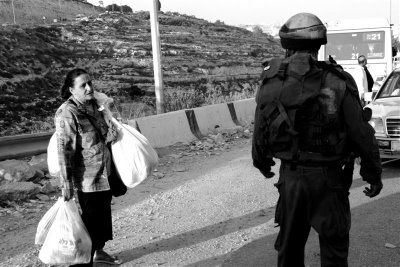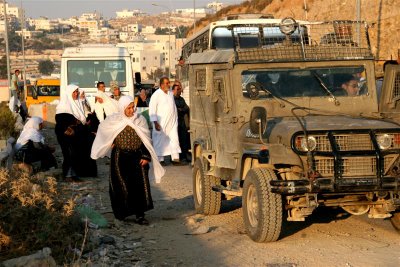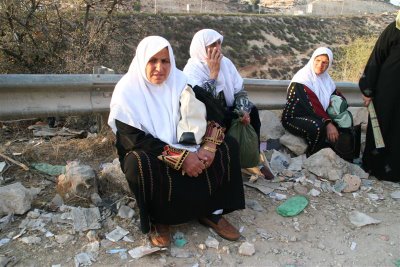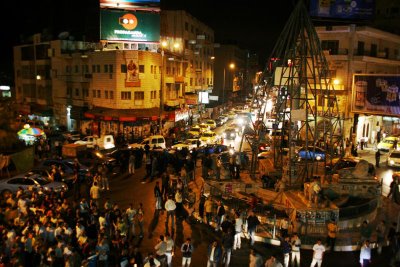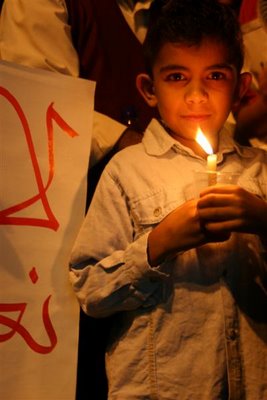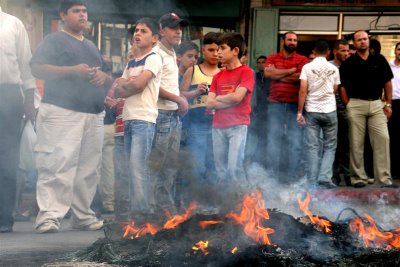The Great Experiment - By Uri Avnery
Date: 16 / 10 / 2006 Time: 14:59
14.10.06
IS IT possible to force a whole people to submit to foreign occupation by starving it?
That is, certainly, an interesting question. So interesting, indeed, that the governments of Israel and the United States, in close cooperation with Europe, are now engaged in a rigorous scientific experiment in order to obtain a definitive answer.
The laboratory for the experiment is the Gaza Strip, and the guinea pigs are the million and a quarter Palestinians living there.
IN ORDER to meet the required scientific standards, it was necessary first of all to prepare the laboratory.
That was done in the following way: First, Ariel Sharon uprooted the Israeli settlements that were stuck there. After all, you can't conduct a proper experiment with pets roaming around the laboratory. It was done with "determination and sensitivity", tears flowed like water, the soldiers kissed and embraced the evicted settlers, and again it was shown that the Israeli army is the most-most in the world.
With the laboratory cleaned, the next phase could begin: all entrances and exits were hermetically sealed, in order to eliminate disturbing influences from the world outside. That was done without difficulty. Successive Israeli governments have prevented the building of a harbor in Gaza, and the Israeli navy sees to it that no ship approaches the shore. The splendid international airport, built during the Oslo days, was bombed and shut down. The entire Strip was closed off by a highly effective fence, and only a few crossings remained, all but one controlled by the Israeli army.
There remained a sole connection with the outside world: the Rafah border crossing to Egypt. It could not just be sealed off, because that would have exposed the Egyptian regime as a collaborator with Israel. A sophisticated solution was found: to all appearances the Israeli army left the crossing and turned it over to an international supervision team. Its members are nice guys, full of good intentions, but in practice they are totally dependent on the Israeli army, which oversees the crossing from a nearby control room. The international supervisors live in an Israeli kibbutz and can reach the crossing only with Israeli consent.
So everything was ready for the experiment.
THE SIGNAL for its beginning was given after the Palestinians had held spotlessly democratic elections, under the supervision of former President Jimmy Carter. George Bush was enthusiastic: his vision of bringing democracy to the Middle East was coming true.
But the Palestinians flunked the test. Instead of electing "good Arabs", devotees of the United States, they voted for very bad Arabs, devotees of Allah. Bush felt insulted. But the Israeli government was ecstatic: after the Hamas victory, the Americans and Europeans were ready to take part in the experiment. It could start:
The United States and the European Union announced the stoppage of all donations to the Palestinian Authority, since it was "controlled by terrorists". Simultaneously, the Israeli government cut off the flow of money.
To understand the significance of this: according to the "Paris Protocol" (the economic annex of the Oslo agreement) the Palestinian economy is part of the Israeli customs system. This means that Israel collects the duties for all the goods that pass through Israel to the Palestinian territories - actually, there is no other route. After deducting a fat commission, Israel is obligated to turn the money over to the Palestinian Authority.
When the Israeli government refuses to pass on this money, which belongs to the Palestinians, it is, simply put, robbery in broad daylight. But when one robs "terrorists", who is going to complain?
The Palestinian Authority - both in the West Bank and the Gaza Strip - needs this money like air for breathing. This fact also requires some explanation: in the 19 years when Jordan occupied the West Bank and Egypt the Gaza Strip, from 1948 to 1967, not a single important factory was built there. The Jordanians wanted all economic activity to take place in Jordan proper, east of the river, and the Egyptians neglected the strip altogether.
Then came the Israeli occupation, and the situation became even worse. The occupied territories became a captive market for Israeli industry, and the military government prevented the establishment of any enterprise that could conceivably compete with an Israeli one.
The Palestinian workers were compelled to work in Israel for hunger wages (by Israeli standards). From these, the Israeli government deducted all the social payments levied on Israeli workers, without the Palestinian workers enjoying any social benefits. This way the government robbed these exploited workers of tens of billions of dollars, which disappeared somehow in the bottomless barrel of the government.
When the intifada broke out, the Israeli captains of industry and agriculture discovered that it was possible to get along without the Palestinian workers. Indeed, it was even more profitable. Workers brought in from Thailand, Romania and other poor countries were ready to work for even lower wages and in conditions bordering on slavery. The Palestinian workers lost their jobs.
That was the situation at the beginning of the experiment: the Palestinian infrastructure destroyed, practically no means of production, no work for the workers. All in all, an ideal setting for the great "experiment in hunger".
THE IMPLEMENTATION started, as mentioned, with the stoppage of payments.
The passage between Gaza and Egypt was closed in practice. Once every few days or weeks it was opened for some hours, for appearances' sake, so that some of the sick and dead or dying could get home or reach Egyptian hospitals.
The crossings between the Strip and Israel were closed "for urgent security reasons". Always, at the right moment, "warnings of an imminent terrorist attack" appeared. Palestinian agricultural products destined for export rot at the crossing. Medicines and foodstuffs cannot get in, except for short periods from time to time, also for appearances, whenever somebody important abroad voices some protest. Then comes another "urgent security warning" and the situation is back to normal.
To round off the picture, the Israeli Air Force bombed the only power station in the Strip, so that for a part of the day there is no electricity, and the water supply (which depends on electric pumps) stops also. Even on the hottest days, with temperatures of over 30 degrees centigrade in the shade, there is no electricity for refrigerators, air conditioning, the water supply or other needs.
In the West Bank, a territory much larger than the Gaza Strip (which makes up only 6% of the occupied Palestinian territories but holds 40% of the inhabitants), the situation is not quite so desperate. But in the Strip, more than half of the population lives beneath the Palestinian "poverty line", which lies of course very, very far below the Israeli "poverty line". Many Gaza residents can only dream of being considered poor in the nearby Israeli town of Sderot.
What are the governments of Israel and the US trying to tell the Palestinians? The message is clear: You will reach the brink of hunger, and even beyond, if you do not surrender. You must remove the Hamas government and elect candidates approved by Israel and the US. And, most importantly: you must be satisfied with a Palestinian state consisting of several enclaves, each of which will be utterly dependent on the tender mercies of Israel.
AT THE moment, the directors of the scientific experiment are pondering a puzzling question: how on earth do the Palestinians still hold out, in spite of everything? According to all the rules, they should have been broken long ago!
Indeed, there are some encouraging signs. The general atmosphere of frustration and desperation creates tension between Hamas and Fatah. Here and there clashes have broken out, people were killed and wounded, but in each case the deterioration was halted before it became a civil war. The thousands of hidden Israeli collaborators are also helping to stir things up. But contrary to all expectations, the resistance did not evaporate. Even the captured Israeli soldier has not been released.
One of the explanations has to do with the structure of Palestinian society. The Hamulah (extended family) plays a central role there. As long as one person in the family is working, the relatives, too, do not die of hunger, even if there is widespread malnutrition. Everyone who has any income shares it with all his brothers and sisters, parents, grandparents, cousins and their children. That is a primitive system, but quite effective in such circumstances. It seems that the planners of the experiment did not take this into account.
In order to quicken the process, the whole might of the Israeli army is now being used again, as from this week. For three months the army was busy with the Second Lebanon War. It became apparent that the army, which for the last 39 years has been employed mainly as a colonial police force, does not function very well when suddenly confronted with a trained and armed opponent that can fight back. Hizbullah used deadly anti-tank weapons against the armored forces, and rockets rained down on Northern Israel. The army has long ago forgotten how to deal with such an enemy. And the campaign did not end well.
Now the army returns to the war it knows. The Palestinians in the Strip do not (yet) have effective anti-tank weapons, and the Qassam rockets cause only limited damage. The army can again use tanks against the population without hindrance. The Air Force, which in Lebanon was afraid to send in helicopters to remove the wounded, can now fire missiles at the houses of "wanted persons", their families and neighbors, at leisure. If in the last three months "only" 100 Palestinians were killed per month, we are now witnessing a dramatic rise in the number of Palestinians killed and wounded.
How can a population that is hit by hunger, lacking medicaments and equipment for its primitive hospitals and exposed to attacks on land, from sea and from the air, hold out? Will it break? Will it go down on its knees and beg for mercy? Or will it find inhuman strength and stand the test?
In short: What and how much is needed to get a population to surrender?
All the scientists taking part in the experiment - Ehud Olmert and Condoleezza Rice, Amir Peretz and Angela Merkel, Dan Halutz and George Bush, not to mention Nobel Peace Price laureate Shimon Peres - are bent over the microscopes and waiting for an answer, which undoubtedly will be an important contribution to political science.
I hope the Nobel Committee is watching.
---
Uri Avnery is the head of the Israeli peace movement, Gush Shalom.


